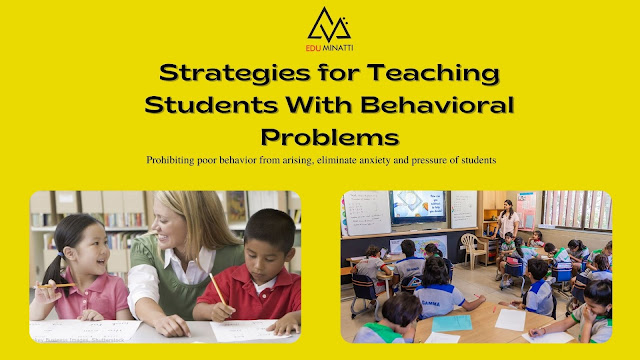Strategies for Teaching Students With Behavioral Problems

The average classroom is probably going to contain one or more students who demand more attention as a result of activity difficulties. In a few cases, hormones, challenges with peers, and home-life issues will make even a "good kid" troublesome. And whereas some academics are specially trained to handle special needs youngsters who demand more time, some aren't. That may hurt each student and, therefore, the teacher.
So, however, will we support these children, whereas conjointly preserving our energy, stamina, and patience? Let's break it down.
First, who has to learn these strategies?
All academics need to learn the way to show students with behavior issues. No matter if the kid is one student in a schoolroom with a concern or if the classroom is intended for children with these complicated activity issues, the methods to teaching and avoiding complications or outbursts are generally the same. Once academics learn the way to avoid situations that may push the button on these youngsters, it's possible to ensure the classroom's lesson plan is absolutely explored, and everyone gets equal attention.
Dealing with the equal attention situation girls boarding schools in India come with the strategy of extra classes after school in which teachers interact with students who look uncomfortable, confused, upset during classes. Which gives students the confidence to reach out to facilities with their problems.
Prior to an occurrence
One of the simplest methods for teaching in an environment like this is often to be told methods that facilitate to prevent the incidence of activity issues. Whereas each student's needs are different, there are some easy steps academics will desire to facilitate in preventing problems as a group.
Increase the number of management present throughout high-risk periods. Once misbehavior is probably going to occur, comparable to during group work sessions or at specific times of the day, adding additional management is a useful step in preventing issues.
Make tasks manageable. To avoid driving stress factors that may cause a child to start to misbehave, ensure that all the tasks you assign will give the student with little bits of knowledge at one time. By dividing a lesson into parts, you are less probably to overwhelm the student.
Offer choices whenever possible. Instead of creating a strict schoolroom routine, give the scholars with choices. For instance, let students opt for that project they work on instead of having to specialize in a specific project.
Ensure youngsters reach out to facilitate. In some cases, behavior problems occur as a result of the kid doesn't know how he or she will receive facilitate or does not, for a few reasons, feel that help is available. Reassure youngsters that they'll reach out for the help they have. If they feel comfortable coming to you once they're lost, upset, or overwhelmed, they're not as probably to possess an outburst.
Prevention is often the simplest step; however, in fact, it's not continually possible to stop each occurrence of poor behavior.
For prohibiting poor behavior from arising schools in Mussoorie encouraging girls to become more vocal in the classroom and providing them a class outing weekly which refresh their mind and students become calmer.
Handling in-the-moment issues
When activity problems begin to occur, academics must react in the right manner. Here are a couple of strategies:
Apologies. Apologies assist in repairing the social conflicts between two individuals. Make sure that all offending parties inspire apologies.
Ignore. In a few cases, the teacher ignores the behavior, which means he or she doesn't react to it or reinforce or reward it.
Reduce privilege access. Once defining the privileges that students have, the teacher sets in place a rule system for taking those away. For instance, things, like having free time or being able to speak with friends, are removed when rules are broken.
Praise. Praiseful positive behavior (not simply expected behavior) is also a way of managing negative outcomes. Once academics praise students more readily than scold them, the student learns that to get the attention, he or she should act completely.
Dealing with conflict within the schoolroom is never easy. However, by obtaining parents concerned, putting time aside to understand the reason for the matter, and by participating youngsters in positive rewards, it should be possible to reduce the number of the risk that behavior issues can get within the way of learning—for you and your students.



Comments
Post a Comment